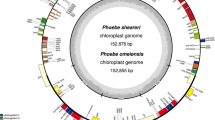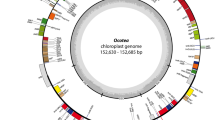Abstract
RFLPs of cpDNA of five species and one variety ofKalimeris, and elght species ofAster from Japan were investigated. Approximately 290 restriction sites were surveyed using 16 restriction enzymes. A total of 52 restriction site mutations was detected, and 21 of them were phylogenetically informative. Wagner parsimony analysis resulted in only one most parsimonious tree.
In the tree obtained,Kalimeris sensu Kitamura is a colyphyletic group;K. miqueliana belongs to a different clade than the remaining species ofKalimeris. This result suggests that the shortening of the pappus has occurred in parallel in different evolutionary line. Thus, it is not appropriate to extend the generic circumscription ofKalimeris to includeK. miqueliana, based on pappus length. The sister group ofKalimeris, exceptK. miqueliana, is theAster ageratoides group.Aster ovatus is included in theKalimeris clade and it is suggested that it represents an amphidiploid with someKalimeris species as its maternal parent.
Similar content being viewed by others
References
Farris, J.S. 1970. Methods for computing Wagner trees. Syst. Zool.19: 83–92.
Felsenstein, J. 1985. Confidence limits on phylogenies: an approach using the bootstrap. Evolution39: 783–791.
Hasebe, M. andIwatsuki, K. 1990.Adiantum capillusveneris chloroplast DNA clone bank: as useful heterologous probes in the systematics of the leptosporangiate ferns. Amer. Fern J.80: 20–25.
Huziwara, Y. 1957a. Karyotype analysis in some genera of Compositae. II. The karyotype of JapaneseAster species. Cytologia22: 96–112.
Huziwara, Y. 1957b. Karyotype analysis in some genera of Compositae. III. The karyotype of theAster aqeratoides group. Amer. J. Bot.44: 783–790.
Huziwara, Y. 1958. Karyotype analysis in some genera of Compositae. IV. The karyotypes within the generaGymnaster, Kalimeris andHeteropappus. Cytologia23: 33–45.
Ito, M. andSoejima, A. 1995.Aster.In K. Iwatsuki, T. Yamazaki, D.E. Boufford, and H. Ohba, eds., Flora of Japan IIIb, Kodansha, Tokyo.
Jansen, R.K. andPalmer, J.D. 1987a. Chloroplast DNA from lettuce and Barnadesia (Asteraceae): structure, gene localization, and characterization of a large inversion. Curr. Genet.11: 553–564.
Jansen, R.K. andPalmer, J.D. 1987b. A chloroplast DNA inversion marks an acient evolutionary split in the sunflower family (Asteraceae). Proc. Natl. Acad. Sci. USA84: 5818–5822.
Kitamura, S. 1937. Compositae Japonicae. I. Men. Coll. Sci. Kyoto Imp. Univ. Ser. B.13: 337–357.
Kitamura, S. 1957. Compositae Japonicae. VI. Mem. Coll. Sci. Kyoto Imp. Univ. Ser. B.24: 1–79.
Swofford, D.L. 1993. PAUP, Phylogenetic Analysis Using Parsimony. Ver. 3.1, Illinois Natural History Survey, Champaign, Illinois.
Saitou, N. andNei, M. 1987. The neighbor-joining method: A new method for reconstructing phylogenetic trees. Mol. Biol. Evol.4: 406–425.
Sugiura, M., Shinozuka, K., Zaita, N., Kusuda, M. andKumano, M. 1986. Clone bank of the tobacco (Nicotiana tabacum) chloroplast genome as a set of overlapping restriction endonuclease fragments: Mapping of eleven ribosomal protein genes. Plant Sci.44: 211–216.
Tara, M. 1972. Cytologenetic studies on natural intergeneric hybridization onAster alliances. l.Aster ageratoides subsp.ovatus (2n=36)×Kalimeris incisa (2n=72). Bot. Mag. Tokyo85: 219–240.
Tara, M. 1973. Cytologenetic studies on natural intergeneric hybridization onAster alliances. II.Heteropappus hispidus (2n=36)×Kalimeris incisa (2n=72). J. Sci. Hiroshima Univ., Ser. B, Div. 2,14: 107–140.
Tara, M. 1977. Cytologenetic studies on natural intergeneric hybridization onAster alliances. IV. Experimental confirmation of the hybrid origin ofAster ageratoides subsp.ovatus. Bot. Mag. Tokyo.90: 253–258.
Watanabe, M., Ito, M. andKurita, S. 1994. Chloroplast DNA phylogeny of Asian bomboos (Bambusoideae) and its systematic implications. J. Plant Res.107: 253–261.
Author information
Authors and Affiliations
Rights and permissions
About this article
Cite this article
Ito, M., Soejima, A., Hasebe, M. et al. A chloroplast-DNA phylogeny ofKalimeris andAster, with reference to the generic circumscription. J. Plant Res. 108, 93–96 (1995). https://doi.org/10.1007/BF02344311
Received:
Accepted:
Issue Date:
DOI: https://doi.org/10.1007/BF02344311




